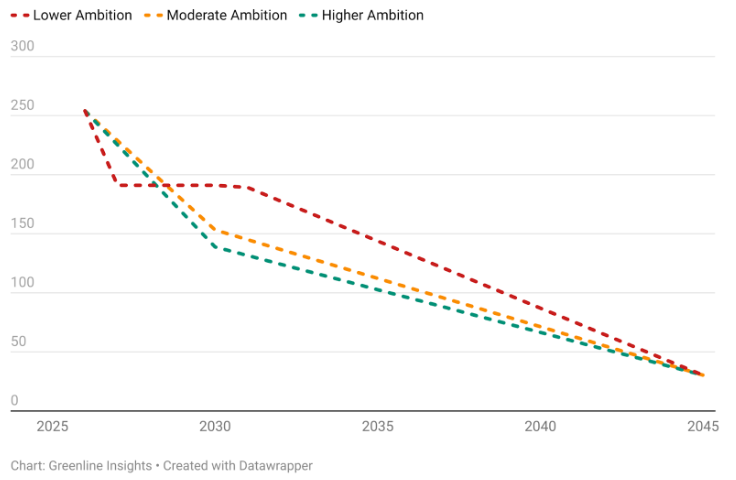California is leading the nation on climate action, with Governor Newsom representing the U.S. at the international climate conference and the state legislature strengthening and extending California’s landmark climate policy, Cap-and-Invest. The state government is taking ambitious action on the climate crisis from all angles and now the spotlight is on the California Air Resources Board (CARB).
As CARB works to update the design of its cap-and-invest program, new modeling shows the state can take ambitious action to cut pollution while still cutting costs for the vast majority of families. More specifically, adopting a more ambitious pollution cap now than what is currently on the table translates into easier, larger pollution cuts over the next 20 years.
By making these changes to the program now, California is investing early in the success of its climate goals. Think of it like a 401k account: the benefits of early action compound over time, paying bigger climate and economic dividends later. If the state waits to act, it’s missing out on years of progress building a safer, more affordable future for Californians.
Where the program stands
Cap-and-Invest is California’s most cost-effective tool to reduce climate-altering pollution and is an important affordability solution for Californians. The program’s binding, declining limit on pollution ensures that emissions are cut over time while prioritizing the most readily available, lowest cost opportunities to reduce pollution. At the same time, the program requires polluters to pay for their emissions — generating a crucial source of revenue that has already reduced household costs through $16 billion in utility bill credits for residential customers and over $30 billion raised for community investments.
CARB is working on updates to the program in order to make sure it is calibrated to meet the state’s climate targets, limiting pollution and driving clean energy investment.
Part of that adjustment means removing emissions allowances from the annual ‘emissions budgets’, translating to less pollution going into the atmosphere. At a workshop last month, CARB presented scenarios for reductions, noting that removing 118 million allowances from the program between now and 2030 would be the bare minimum needed to achieve our targets.
New modeling shows CARB can pursue a more ambitious path — cutting more emissions while improving affordability for working families.
Modeling results: a more ambitious cap is affordable
The modeling from Greenline Insights finds that, if California adopts a tighter near-term emissions cap by removing 154 million allowances through 2030 instead of the minimum 118 million, it would cut significantly more pollution while saving money –
- Over $600 million in net savings through 2045 – for families earning $100,000 or less annually (more than half of California households).
- Lower-income families that earn $70,000 or less receive the biggest affordability gains from a more ambitious emissions cap: $2.2 billion in net savings through 2045.
This “Higher Ambition” scenario would result in 586 million emissions allowances removed from the program cap, cumulatively, between 2027 and 2045. A tighter near-term emissions cap would maintain market stability and deliver a steadily increasing but modest price signal, stimulating long-term investment in clean technologies while avoiding hitting price containment features built into the program.
The modeling shows that more ambitious pollution reduction now is not only possible, but would provide meaningful cost savings to working families in California. CARB should swiftly adopt the “Higher Ambition” scenario in order to deliver on the promise of strong climate action at the exact moment when state leadership is so badly needed.
Figure 1: Modeled Cap Trajectories, MMTCO2e
What we find is that a higher-ambition cap doesn’t destabilize the market, but rather improves it.” said Jonah Kurman-Faber, Founder and Principal at Greenline Insights. “Even with deeper allowance removals, prices stay within expected bounds, maintaining a predictable market signal and providing net benefits for lower- and middle-income households.
Next steps
The Cap-and-Invest Program is already helping lower costs for families by putting money directly back into Californians’ pockets.
As CARB presides over the rulemaking process determining the program’s next steps, one conclusion is clear: cutting pollution quickly now helps save Californians money.
Ambitious action can also help prevent the growth of a climate-induced affordability crisis:
- California faces more than $16 billion in climate-related disaster costs every year — the highest in the nation.
- Home insurance is becoming harder and more expensive to obtain, while families and communities are paying the price of extreme heat, floods and wildfires.
- Over the past decade alone, major heat events caused $7.7 billion in losses.
- Wildfire smoke exposure has contributed to more than 50,000 deaths and more than $400 billion in economic damages.
By acting on the science and strengthening the cap-and-invest program’s emissions cap, CARB can help secure a cleaner, more affordable future for all Californians.











